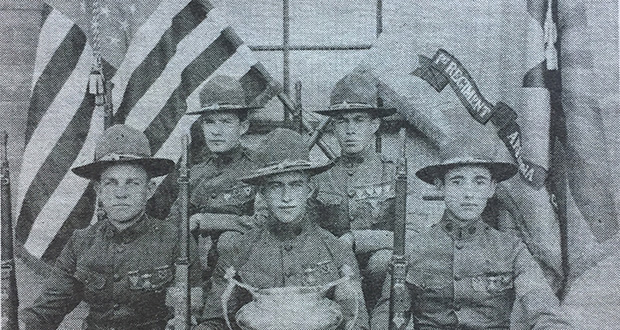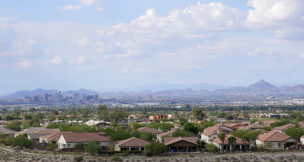For Sale — This Place — And Cow
Arizona Capitol Reports Staff//October 6, 2006//[read_meter]

This 1937 photo, snapped during the Great Depression, shows how the dire economic conditions of the time forced people to sell whatever they could to get by.
When the Great Depression rolled across Arizona during the 1930s, it did not bypass the San Pedro Valley, where this sign — For Sale-This Place-And Cow — was caught on film at St. David by an alert photographer in 1937.
Although hard times were known everywhere in the state, St. David may have fared better than some Arizona towns. It was, after all, a Mormon community, and certain aspects of communalism were not unknown to its people. Sharing labor and resources, particularly in difficult times, had long been a practice of Latter-day Saints.
Still, the Depression’s debilitating effect was felt almost universally. On Feb. 14, 1933, Arizona banks joined others across the nation in closing their doors when the new chief executive, Franklin D. Roosevelt, declared a bank holiday. The public held its collective breath when, two weeks later, most banks reopened. Riggs Bank in nearby Willcox was ordered to reorganize. It did so as the Bank of Willcox, and its Bowie branch was closed. A more ominous note was struck when the doors of Benson’s Cochise County State Bank remained padlocked. The bank did not reopen. Consequently, more than a few residents lost their life’s savings, or saw mortgages sold indiscriminately to banks anxious to call loans. It was not a happy time.
Meantime, the Southern Pacific Railroad, a major employer, announced abandonment of more than 70 miles of track in Cochise County operated by two subsidiaries — Arizona Eastern Railroad, and the El Paso & Southwestern. The result was layoffs, loss of personal income, dislocation, and reduction of taxable income to the county.
Optimism flared in 1934 when Kaiser-Betchel, the giant construction company, announced plans to build a pipeline from Douglas to Phoenix for the Western Gas Company. The construction firm agreed to retire its heavy equipment and trench its way across southern Arizona using manual labor. The path of construction was plotted in grids, and within each grid local men were hired to work at 40-cents an hour. As a new grid was entered, the workers were released and a new batch hired. Consequently, thousands of men were put to work, although none were retained for more than a few weeks. When the project entered the San Pedro Valley, men from St. David, Benson, Pomerene, and outlying ranches formed lines at the employment office.
In July 1935, the federal government announced that Camp 19A of the Civilian Conservation Corps (CCC) would be installed at St. David. “All day Saturday,” noted the Arizona Daily Star on August 1, “truckloads of material for the buildings were hauled into the camp [and a] number of local men are employed in trucking and construction work.”
Some 200 young men, mostly from New England, were billeted at St. David. Not only was their presence an economic boon, but provisioning the camp itself did much to stimulate the local economy.
As a young farm boy living in Pomerene, Vay Fenn recalled visiting the camp with his father. Hot dogs were served at mealtime and the visitors were encouraged to help themselves. They did, and Fenn recalled the hot dogs as one of the best meals he had ever eaten. It was a welcome respite from the dreary sameness of his Depression-induced diet.
At Benson, an abandoned smelter just north of the railroad tracks became a hobo jungle. Townsfolk tolerated the arrangement and only rarely were there problems. Traveling men — and more than a few women — seeking work, spent a night or two in the camp, then hopped a freight and were on their way.
Recalling a visit with Governor Benjamin Moeur in the summer of 1935, San Pedro Valley News publisher D.F. Mellenbruch wrote, “I almost broke down and cried when he said that grown men came into his office with tears in their eyes pleading for means to support their undernourished children.”
It was not until the onset of World War II did Arizona’s economy rebound from more than a decade of brutal stagnation.
— W. Lane Rogers. Photo courtesy of author.

















